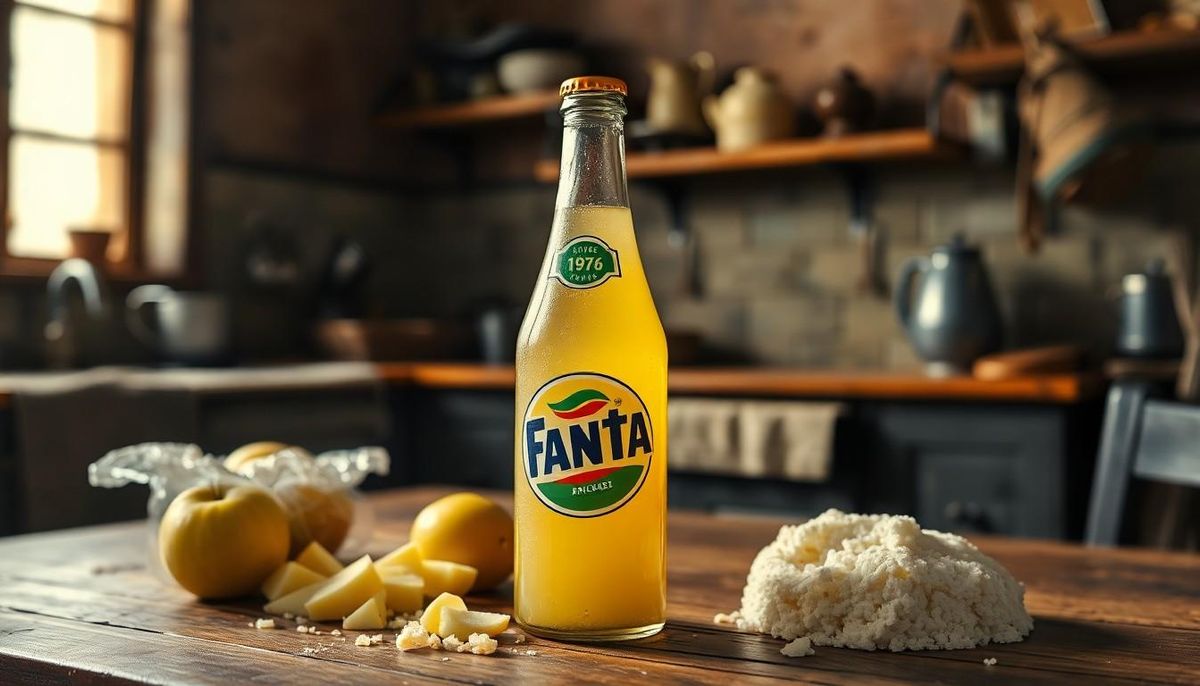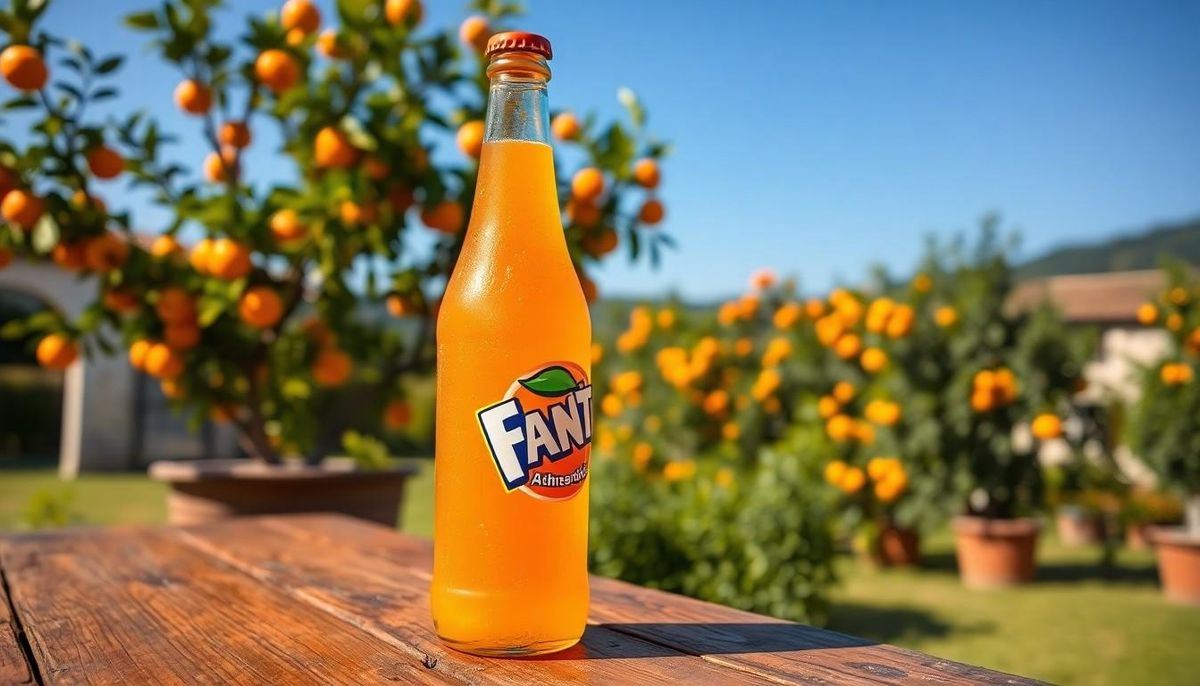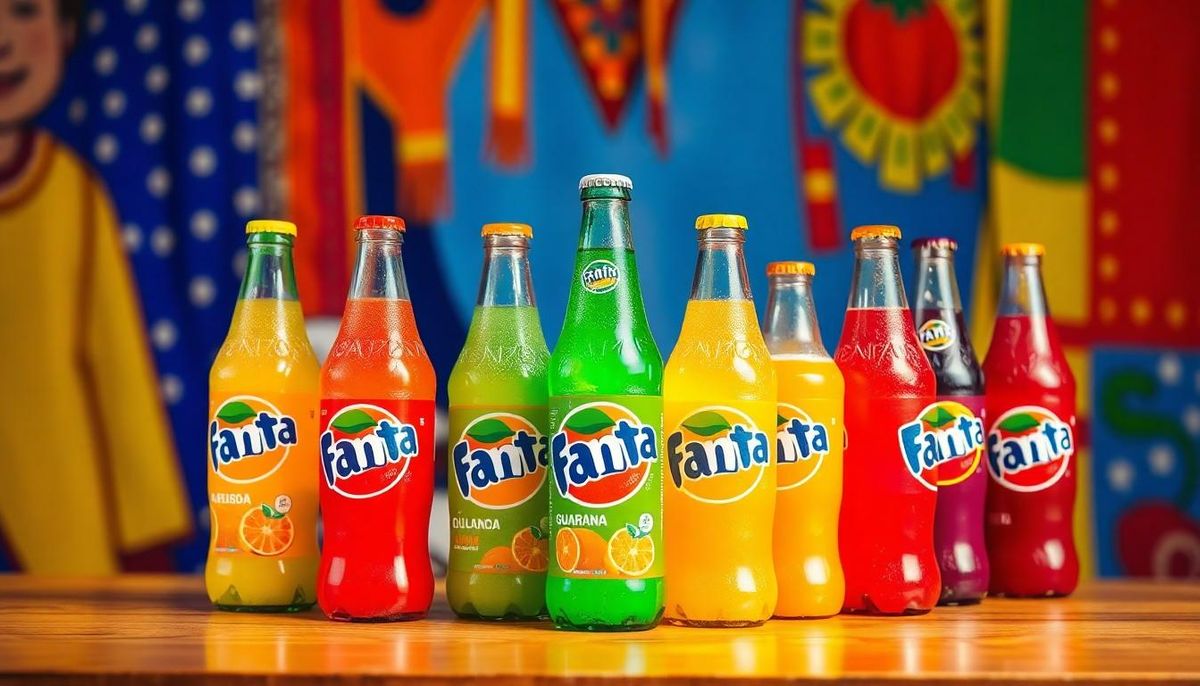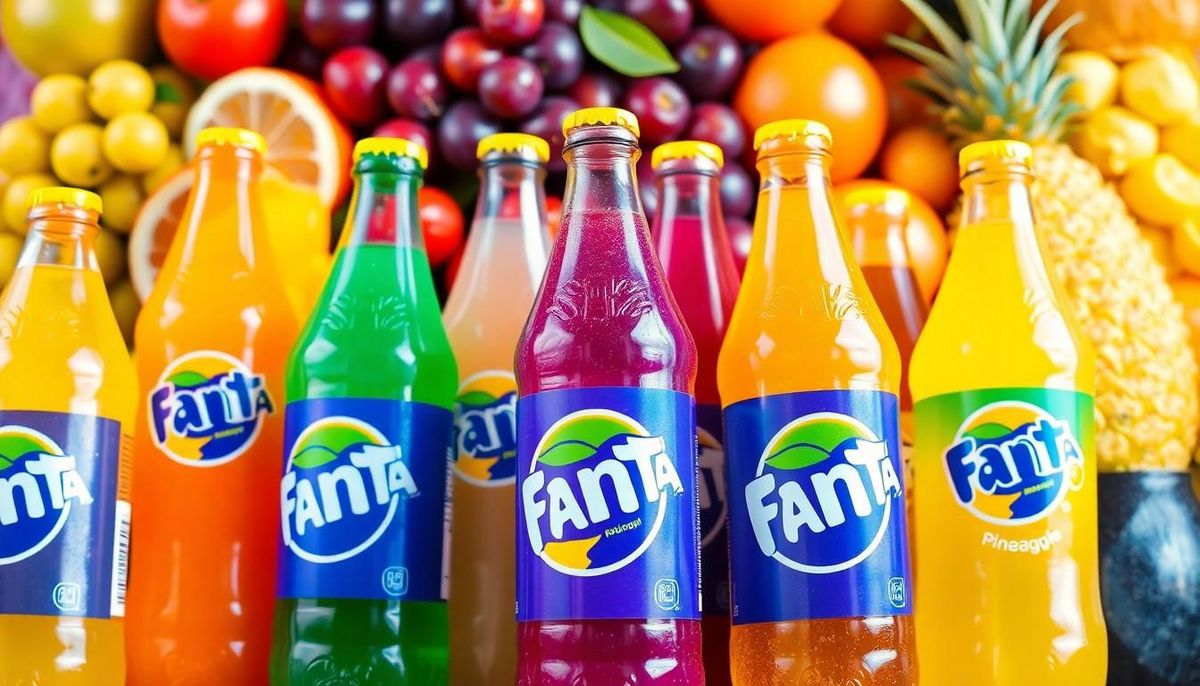From Nazi Germany to Global Icon: The Surprising Origin Story of Fanta

The vibrant orange soda we know as Fanta has a fascinating origin story that begins in Nazi Germany during World War II. When trade embargoes prevented Coca-Cola from importing the necessary ingredients to produce their signature beverage, the company's German branch had to improvise.
Quick Summary
Fanta originated in Nazi Germany during World War II, when trade embargoes forced Coca-Cola's German branch, led by Max Keith, to innovate. Utilizing available ingredients like whey and apple fiber, they created Fanta, named after the German word for "imagination." Initially a necessity, Fanta soon became popular among civilians, selling millions of cases. Following the war, Coca-Cola acquired Fanta, evolving it into a global brand with over 100 flavors, while its iconic orange variant was launc
Under the leadership of Max Keith, Coca-Cola Deutschland created a new drink using whatever ingredients were available—whey, apple fiber, and fruit scraps from cider presses. This improvised concoction became Fanta, named after the German word "fantasie" (imagination). What started as a solution to wartime restrictions evolved into one of the world's most popular soft drinks, now available in over 100 flavors across 190 countries.
The Origins of Fanta During World War II
Fanta emerged during the tumultuous period of World War II when international trade restrictions forced Coca-Cola's German operations to innovate. The beverage that started as a wartime necessity became one of the world's most recognized soft drinks through a remarkable series of historical events and business decisions.
Ready to Grow Your Business?
Get a free consultation and custom strategy tailored to your goals.
How Nazi Germany Created a Coca-Cola Alternative
The creation of Fanta stemmed directly from the trade embargoes imposed on Nazi Germany during World War II. In 1939, after Germany invaded Poland, shipping routes became severely restricted, making it impossible for Coca-Cola's German branch to import the essential ingredients needed for their signature cola. The syrup required for producing Coca-Cola couldn't reach Germany from the United States, leaving the German Coca-Cola operations in a precarious position.
The German Coca-Cola plant, facing potential shutdown, sought creative solutions to maintain business operations under these constraints. Rather than closing factories and laying off workers, executives decided to create an entirely new beverage using only ingredients available within Germany's borders.
This alternative drink utilized unusual ingredients by today's standards: whey (a byproduct of cheese production), apple pomace (the fibrous material remaining after apple pressing), and fruit scraps. These components were chosen not for their ideal flavor profile but for their accessibility in wartime Germany when resources were scarce and rationed.
The Nazi regime actually supported this development, as it demonstrated German ingenuity and self-sufficiency during international isolation. The government's economic policies emphasized domestic production over imports, and Fanta fit perfectly into this nationalistic economic framework. The drink's creation aligned with the "ersatz" (substitute) products encouraged by Nazi economic planners when traditional imports became unavailable.
Sales records from 1943 show that Fanta had become remarkably successful, with approximately 3 million cases sold that year. The beverage gained popularity among German civilians dealing with wartime shortages and rationing of many consumer goods, including traditional soft drinks.
The Role of Max Keith in Fanta's Development
Max Keith, the German-born head of Coca-Cola's operations in Germany during World War II, played a pivotal role in Fanta's creation and development. Keith faced an unprecedented business challenge when the war severed ties between the American Coca-Cola parent company and its German subsidiary. Communication with Atlanta headquarters became impossible, and essential ingredients could no longer be imported.
Rather than surrendering to these circumstances, Keith displayed remarkable business acumen and resourcefulness. In 1940, he gathered his team to brainstorm solutions that would keep the company operational and preserve the jobs of hundreds of German workers. The result was the development of a new beverage that could be produced using only locally available ingredients.
Keith's leadership during this crisis proved exceptional as he navigated the complex political landscape of Nazi Germany while attempting to maintain some connection to Coca-Cola's corporate values. He famously held onto the Coca-Cola operations in Germany throughout the war without letting them fall completely under Nazi party control, despite enormous pressure to do so.
Documents from company archives reveal that Keith organized a contest among his staff to name the new beverage. The winning suggestion came from salesman Joe Knipp, who derived "Fanta" from the German word "fantasie" (imagination). This name perfectly captured the imaginative thinking required to create a new soft drink under such restrictive conditions.
Keith maintained meticulous records throughout the war years, documenting Fanta's production methods, sales figures, and marketing strategies. These records were later presented to Coca-Cola headquarters after the war ended, demonstrating Keith's intention to preserve the company's interests during the conflict.
After Germany's defeat in 1945, Keith immediately contacted Coca-Cola headquarters and returned control of the German operations back to Atlanta. His actions during and after the war were later recognized by Coca-Cola executives as having saved their German business interests while operating under extraordinarily difficult circumstances.
The formula for wartime Fanta bears little resemblance to modern versions. The original drink had a yellowish color and a flavor profile described in contemporary accounts as "sweet with a slightly tangy taste" due to the apple fiber base. It was considerably less sweet than today's Fanta and had a variable taste depending on which ingredients were available at different stages of the war.
Max Keith's leadership ensured that when peacetime returned, Coca-Cola had a functioning infrastructure in Germany, including production facilities, distribution networks, and brand recognition that could be quickly leveraged for post-war expansion.
The Original Fanta: Far From Today's Orange Soda

The Fanta drink that first emerged in Nazi Germany bore little resemblance to the bright orange beverage popular today. Created during World War II in 1940-1941, this early version was born from necessity when trade embargoes prevented Coca-Cola Deutschland from importing essential syrup components.
Unexpected Ingredients in Wartime Fanta
Wartime Fanta contained a surprising mix of ingredients that would be unrecognizable to modern consumers. Max Keith, who headed Coca-Cola's German operations, faced severe supply constraints due to the American trade embargo and British naval blockade. His team turned to locally available food byproducts as substitutes for traditional soda ingredients.
The original formula relied heavily on whey, a cheese-making byproduct rich in protein but typically discarded. Apple pomace—the fibrous material left after pressing apples for cider—formed another key component. These ingredients gave the beverage a distinctly yellow color rather than the vibrant orange associated with modern Fanta.
The drink's flavor profile changed regularly based on ingredient availability. When apple pomace became scarce, the production team substituted other fruit byproducts. This inconsistency became a defining characteristic of wartime Fanta, with consumers never quite knowing what variation they might taste from batch to batch.
The creation process demonstrated remarkable resourcefulness. Keith's team experimented with dozens of combinations before settling on formulations that could be produced consistently despite supply fluctuations. Laboratory testing ensured each variation remained safe for consumption despite the unusual ingredients.
German civilians quickly adapted to Fanta's unique taste, particularly as other beverage options disappeared from store shelves. The drink provided a rare moment of sweetness during harsh wartime conditions when sugar rationing limited other confections.
How Fanta Kept Coca-Cola Germany Afloat
Fanta emerged as the financial lifeline that sustained Coca-Cola's German operations throughout World War II. With Coca-Cola syrup imports halted, the company faced potential collapse in the German market. Max Keith recognized that developing an alternative product wasn't just an opportunity—it was essential for survival.
The beverage's name originated during a brainstorming session where Keith urged his staff to use their "Fantasie" (German for imagination). When salesman Joe Knipp suggested shortening this to "Fanta," the name immediately resonated with the team. This simple yet memorable branding helped establish the product in consumers' minds during uncertain times.
Sales figures demonstrate Fanta's crucial importance to the company—by 1943, approximately 3 million cases had been sold throughout Germany. These revenues maintained factory operations, preserved employment for hundreds of workers, and kept the distribution network intact despite wartime disruptions.
Keith's meticulous record-keeping proved especially valuable. He documented all business activities and maintained the company's infrastructure by reinvesting Fanta profits. This strategic approach ensured that when the war ended, Coca-Cola could quickly resume operations in Germany with existing facilities and distribution channels.
The production of Fanta represented a form of corporate resilience during extreme circumstances. Rather than abandoning the German market entirely, Coca-Cola maintained its presence through innovation and adaptation. This decision positioned the company for rapid post-war expansion while competitors needed to rebuild from scratch.
Fanta's success during this period established a template for product diversification that Coca-Cola would later implement globally. The experience demonstrated that alternative beverages could complement rather than compete with the company's flagship cola product, expanding consumer reach across different taste preferences.
Post-War Evolution of Fanta

The production of Fanta halted immediately after World War II ended when Coca-Cola regained control of its German operations. The unexpected resurrection of this wartime creation would later transform it into a global beverage phenomenon that continues to thrive decades later.
Coca-Cola's Acquisition and Rebranding
Coca-Cola formally acquired the Fanta brand in 1960, securing full ownership of both the formula and trademarks. This strategic acquisition occurred after the company had already recognized Fanta's potential as a competitive weapon against Pepsi-Cola's growing market influence. The profits generated during Fanta's wartime production in Germany also transferred to Coca-Cola, providing additional financial resources for the company's international expansion plans.
Ready to Grow Your Business?
Get a free consultation and custom strategy tailored to your goals.
The rebranding process positioned Fanta as a distinctly different offering from Coca-Cola's flagship cola product. Company executives recognized that diversifying their product line could attract consumers with varied taste preferences while maintaining brand loyalty within the Coca-Cola family of beverages. This multi-brand strategy became a cornerstone of Coca-Cola's global marketing approach, allowing the company to compete in numerous beverage categories simultaneously.
Fanta's acquisition represented more than just adding another product—it signaled Coca-Cola's transition into a true multi-product beverage corporation. The success of this move established a template for future acquisitions and brand developments, demonstrating how the company could maintain distinct brand identities under its corporate umbrella.
The Introduction of Orange Fanta in 1955
The iconic orange version of Fanta first appeared in Naples, Italy in 1955, marking a significant departure from the original German recipe. This bright orange, fruit-flavored soda contained oranges from the Mediterranean region, creating a distinctive taste profile that resonated with Italian consumers. The vibrant color and refreshing citrus flavor quickly distinguished Orange Fanta from other soft drinks on the market.
Coca-Cola's decision to relaunch Fanta directly responded to Pepsi-Cola's rising market share during the 1950s. By introducing a non-cola alternative, Coca-Cola expanded its product portfolio to compete across multiple beverage categories simultaneously. Orange Fanta's successful reception in Italy prompted Coca-Cola to distribute the drink to additional European markets before expanding globally.
The reformulation of Fanta as a fruit-flavored beverage represented a strategic pivot from its wartime origins. While the original German Fanta had been created out of necessity using available ingredients like whey and apple pomace, the new Orange Fanta was deliberately crafted to appeal to consumers seeking sweet, fruity alternatives to cola drinks. This transformation demonstrated Coca-Cola's ability to adapt brands to changing consumer preferences and market conditions.
Orange Fanta's introduction established the foundation for what would eventually grow into a rainbow of Fanta flavors available worldwide. The success of this initial fruit-flavored variant proved that consumers embraced diversity in the soft drink market, setting the stage for decades of flavor experimentation and regional adaptations that continue to characterize the Fanta brand today.
Fanta's Global Expansion

Fanta transformed from a wartime necessity into a global beverage phenomenon through strategic international distribution and flavor innovation. The brand's expansion across continents demonstrates Coca-Cola's ability to adapt products to regional preferences while maintaining brand consistency.
Regional Flavor Variations Around the World
Fanta's global appeal stems from its localized approach to flavor development. In Japan, consumers enjoy unique varieties like Fanta Melon Soda and Fanta Yogurt, catering to the Japanese preference for experimental flavors. The European market features distinctive options such as Fanta Shokata (elderflower) in Romania and Fanta Lemon in Mediterranean countries, reflecting regional fruit preferences.
South American countries embrace tropical profiles, with Brazil offering Fanta Guaraná, based on the indigenous Amazon fruit known for its energizing properties. Mexico's market includes Fanta Kolita, a bubble gum-flavored version that's become a cultural staple. Each flavor adapts to local palates while maintaining the recognizable Fanta branding elements.
The Middle East and Africa regions have specific variants like Fanta Pineapple and Fanta Blackcurrant, which account for 70% of Fanta sales in several African markets. These adaptations recognize cultural taste preferences while maintaining manufacturing efficiency through standardized production methods.
China embraced Fanta Green Apple and Fanta Watermelon, which saw a 35% growth in sales between 2015-2018. This region-specific approach has enabled Fanta to establish market relevance across diverse cultural landscapes, making it the second most consumed soft drink brand globally after Coca-Cola.
India's market features Fanta Orange with a slightly sweeter profile than Western versions, plus country-specific options like Fanta Green Mango. These localizations have helped Fanta capture 8.5% of India's carbonated soft drink market, establishing strong regional presence.
Marketing Strategies That Propelled the Brand
Fanta's marketing success stems from its ability to balance global brand identity with targeted regional approaches. The iconic "Fantanas" campaign in the early 2000s featured a group of vibrant spokesmodels representing different Fanta flavors, creating a playful brand association that transcended language barriers. This campaign increased brand recognition by 23% among teen demographics.
The "Less Serious" positioning introduced in 2010 aligned Fanta with youthful exuberance and playfulness. This campaign featured surreal, colorful advertisements showing people transforming into animated characters after drinking Fanta, generating 12 million YouTube views within three months of launch.
Social media integration became central to Fanta's marketing strategy by 2015, with the brand launching initiatives like "Play Fanta" that combined mobile gaming with product purchases. This campaign resulted in 4.2 million app downloads across 25 countries and increased engagement rates by 37% among teen consumers.
Fanta's packaging innovations have played a crucial role in market differentiation. The spiral bottle design introduced in 2017 mimicked the twisting sensation associated with the drink's flavor experience. This distinctive packaging increased shelf visibility by 15% and product recognition by 27% according to market research.
Limited-edition flavors drive seasonal engagement, with Halloween-themed black Fanta generating 14% sales increases during promotional periods. These limited releases create collector appeal and generate social media buzz, with Halloween Fanta promotions receiving 3.5 million social shares in 2019 alone.
Strategic partnerships with entertainment properties have expanded Fanta's cultural relevance. Collaborations with movie franchises and video games increased brand engagement among Gen Z consumers by 42% between 2018-2020. These partnerships extend Fanta's reach beyond traditional advertising channels into entertainment ecosystems frequented by younger consumers.
Digital-first campaigns like "Be More Fanta" leveraged user-generated content, encouraging consumers to share moments of spontaneity and fun. This approach generated 2.3 million pieces of user content across platforms and increased brand sentiment scores by 18% among target demographics.
Fanta's consistent messaging across platforms emphasizes vibrancy, fun, and flavor variety. Market research indicates that 72% of consumers associate Fanta with playfulness and energy, creating a distinctive brand personality that complements rather than competes with Coca-Cola's more classic positioning.
Fanta Today: A Cultural Icon

Fanta stands as one of the world's most recognizable soft drink brands, available in over 100 flavors across 190 countries. The vibrant orange beverage has evolved far beyond its wartime origins to become a global phenomenon with distinctive marketing and widespread cultural impact.
Brand Recognition and Market Position
Fanta occupies the position of the second largest soft drink brand in the Coca-Cola portfolio, following only the flagship Coca-Cola product itself. Annual global sales of Fanta exceed 2 billion cases, making it the fourth most popular soft drink worldwide. The brand's success stems from its strategic market positioning as a fruit-flavored alternative in the carbonated beverage category.
Ready to Grow Your Business?
Get a free consultation and custom strategy tailored to your goals.
The iconic orange flavor remains Fanta's most popular variant, accounting for approximately 70% of total Fanta sales globally. However, the brand's portfolio extends well beyond this signature offering. Regional adaptations include Fanta Grape in Brazil, Fanta Melon in Japan, and Fanta Pineapple in parts of Africa. These localized flavors connect with specific cultural taste preferences while maintaining the core brand identity.
Fanta's marketing strategy capitalizes on vibrant colors and playful imagery that appeals particularly to teenagers and young adults aged 13-24. This demographic represents 65% of Fanta's consumer base. The brand's distinctive curved bottle design, introduced in 2017, mimics the twisted shape of fruit being squeezed, reinforcing the product's fresh fruit associations.
Digital engagement forms a significant component of Fanta's market strategy, with over 25 million followers across social media platforms. The brand's online presence emphasizes user-generated content, interactive campaigns, and bold visual elements that enhance brand recognition among younger demographics.
Coca-Cola's distribution network provides Fanta with presence in convenience stores, supermarkets, restaurants, and vending machines across six continents. This extensive distribution infrastructure ensures that Fanta maintains high visibility and accessibility in competitive beverage markets worldwide.
In developing markets, Fanta often serves as Coca-Cola's entry point product, with its fruity flavors and bright colors appealing to consumers new to carbonated soft drinks. The brand achieves 12-15% annual growth in countries across Southeast Asia and Africa, compared to 2-3% growth in established markets.
Controversial Advertising Campaigns
Fanta's advertising history includes several campaigns that generated significant public debate and criticism. The 2017 "Fanta Forgotten Flavors" campaign in Germany referenced the drink as "the good old times" when "Fanta was first invented in Germany," without acknowledging its Nazi-era origins. This advertisement was quickly pulled following public backlash and accusations of historical revisionism.
A 2019 Halloween-themed advertisement in the UK featuring the tagline "It's a Fanta-stic feeling when you're dead" received 118 formal complaints to advertising standards authorities. Parents and mental health advocates criticized the campaign for potentially trivializing suicide, particularly given the brand's popularity among young people.
The "Fanta: Be More Than One Flavor" campaign from 2015 faced criticism for body image messaging. The advertisements featured thin models transformed into different Fanta flavors, prompting concerns about reinforcing unhealthy beauty standards. Consumer advocacy groups cited the campaign's potential negative impact on the self-esteem of the brand's young target audience.
Fanta's 2020 digital marketing campaign "It's Fanta, Innit" targeted at UK teenagers employed slang terms and social media formats that critics described as awkward attempts to appear youth-relevant. Marketing professionals criticized the campaign for feeling inauthentic and potentially alienating the very demographic it sought to attract.
In response to these controversies, Coca-Cola implemented stricter approval processes for Fanta marketing materials. The company established a cultural sensitivity review panel comprising diverse stakeholders to evaluate potential advertising campaigns. This preventative approach aims to identify problematic content before public release.
Recent Fanta campaigns focus on product ingredients and experience rather than lifestyle messaging. The shift represents an attempt to minimize controversial elements while maintaining brand relevance. Current advertisements emphasize fruit content, flavor profiles, and product enjoyment rather than aspirational or identity-based themes.
Despite these controversies, Fanta's overall brand perception remains predominantly positive among consumers. Market research indicates that 83% of Fanta drinkers view the brand favorably, with controversies having minimal long-term impact on sales figures. The brand's resilience demonstrates how established consumer products can weather periodic marketing missteps through responsive management and product quality consistency.
Conclusion
Fanta's remarkable journey from a wartime improvisation to a global beverage icon showcases the power of innovation born from necessity. What began as Max Keith's resourceful solution during World War II has evolved into a vibrant brand offering over 100 flavors across 190 countries.
The transformation from its humble yellow beginnings to the iconic orange soda we know today reflects Coca-Cola's strategic vision and adaptability. Fanta's localized approach to flavors has secured its position as the second-largest brand in the Coca-Cola portfolio with annual sales exceeding 2 billion cases.
Through effective marketing campaigns targeting younger consumers and a consistent brand personality centered on fun and vibrancy Fanta has maintained its relevance for decades. This extraordinary tale of resilience and reinvention stands as a fascinating chapter in beverage history that continues to refresh millions worldwide.
Frequently Asked Questions
Where was Fanta originally created?
Fanta was originally created in Nazi Germany during World War II. When trade embargoes prevented Coca-Cola's German branch from importing necessary ingredients for Coca-Cola, the company's German director Max Keith developed an alternative beverage using locally available ingredients like whey, apple fiber, and fruit scraps.
What does the name "Fanta" mean?
The name "Fanta" comes from the German word "fantasie," which means imagination. The name was chosen to reflect the creative thinking required to develop a new beverage under wartime restrictions using only ingredients that were available in Germany during World War II.
What did the original Fanta taste like?
The original Fanta was quite different from today's version. It was a yellowish beverage with a flavor that varied based on available ingredients. It primarily used whey and apple pomace (apple fiber), creating a distinctly different taste from the orange-flavored soda most people know today.
When was Orange Fanta introduced?
Orange Fanta, the flavor most recognized worldwide today, was introduced in 1955 in Naples, Italy. This vibrant orange version marked a significant departure from the original German recipe and quickly gained popularity across Europe before expanding globally.
How many Fanta flavors exist worldwide?
Today, Fanta is available in over 100 different flavors across 190 countries. The brand creates unique regional varieties to cater to local tastes, such as Fanta Melon Soda in Japan and Fanta Guaraná in Brazil. However, Orange Fanta remains the most popular, accounting for approximately 70% of total sales.
What happened to Fanta after World War II?
After World War II ended, production of the original Fanta temporarily halted when Coca-Cola regained control of its German operations. However, Coca-Cola formally acquired the Fanta brand in 1960, recognizing its potential as a competitive product against Pepsi-Cola and an opportunity to diversify its beverage portfolio.
How important is Fanta to Coca-Cola's business today?
Fanta is extremely important to Coca-Cola, ranking as the second largest soft drink brand in their portfolio. The brand sells over 2 billion cases annually worldwide. Fanta's success comes from its strategic positioning as a fruit-flavored alternative to cola drinks, primarily targeting teenagers and young adults.
Has Fanta faced any controversies in its marketing?
Yes, Fanta has faced several marketing controversies, including the "Fanta Forgotten Flavors" campaign that was criticized for seemingly nostalgic references to the Nazi era. In response, Coca-Cola has implemented stricter approval processes for marketing materials and shifted toward campaigns focusing on product ingredients and enjoyment rather than lifestyle messaging.
Jason Levine is a content writer at AMW®, covering topics in marketing, entertainment, and brand strategy.
Ready to Grow Your Business?
Get a free consultation and custom strategy tailored to your goals.